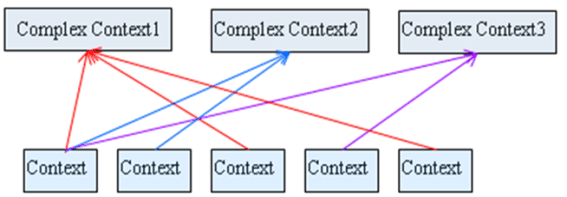|
|
 |
 |
 |
|
| A concept of "context-awareness" is suggested with ubiquitous computing. Context awareness technique is used for services that provide proper and intelligent application to the user by accepting context information according to the user��s environment. Context can be considered as a set of information that includes user��s activity, location, personal preferences and current status while the most widely accepted formal definition has been provided by Dey and Abowd: "Context is any information that can be used to characterize the situation of an entity. An entity can be a person, place, or object that is considered relevant to the interaction between a user and an application, including the user and applications themselves." In the previous study, we classify contexts into unitary and composite contexts. We define the unitary context is a basic building block that is not further dividable. We define the composite context information as enhanced high level context abstraction by integration or composing unitary context information related with multi-entities to decide or supply the service of system. In order to provide composite contextual service, multiple unitary contexts are combined. For example, suppose that a tourist is planning to visit some attraction site near his home. Then, visiting attraction site near home would be considered as composite context. To construct the composite context, the following various unitary contexts will be related to the composite context: weather, allowed time, distance to the site, budget, accompanying people, transportation, etc. Future context-aware service is expected to form such composite context information. While providing a usable context to users is important, it is also essential to reserve such a composite context even if it is not available. To support this composite context-awareness service, event-control-action (ECA) architecture can be used. The pattern matching algorithm which is used in the inference engine of the ECA is the most important part since it decides system performance. For this reason, we analyze existing algorithm of the inference engine such as RETE, TREAT, and LEAPS. The RETE algorithm searches thoroughly all rules, which makes its matching overhead significantly large. The TREAT algorithm provides better run-time performance by removing the burden of managing beta memory. The LEAPS algorithm, on the other hand, computes at most one match per cycle. Therefore, it provides significantly better matching performance than others; however, it may provide wrong result for some applications. |
 |
| Concept of complex context |
|
|
|
 |
|
 |
 |
 |
|
 |
W. Na, S. Cho, E. Kim, and Y. Choi "Event Detection in Composite Context Aware-Service," in Proc. of ICUFN, Dalian, China, June 2011. [PDF] |
 |
W. Na, G. Lee, S. Cho, and Y. Choi "Automatic Intelligence Application for Office Environment," in Proc. of ICOIN, Kuala Lumpur, Malaysia, January 2011. [PDF] |
 |
G. Lee, W. Na, S. Cho, and E. Kim, "Complex Context Information for Video Streaming Service," in Proc. of ICOIN, Kuala Lumpur, Malaysia, January 2011. [PDF] |
 |
�̰ǿ�, ������, ������, ����ö, ������ "���� ��Ȳ ���� ������ ȿ���� ó������(A Study on Complex Context Aware Services via Smart Office)," HCI2012 �м���ȸ, ������, January 2012. [PDF] |
 |
�̰ǿ�, �ڷ���, ������, ������, ������, ������, �ֿ���, "Smart Office Service ������ ���� ���� ��Ȳ���� ����(A Study on the Complex Context Awareness
for Smart Office Service)," �ѱ������ȸ �ϰ������м���ǥȸ, ����, June 2011. [PDF] |
|
|
|
 |
|
|
|
|
|
